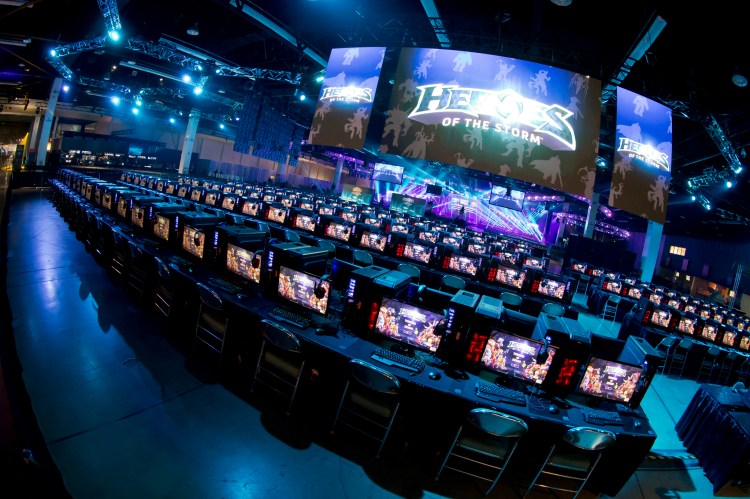U.S. sales of console and PC games are expected to hit $25.3 billion in 2016, up 7.6 percent from $23.5 billion a year earlier, according to a new report from Adobe.
The game sector is growing in large part because of booming online games and online game sales, which will account for $11.1 billion this year, or 44 percent of total sales, said Becky Tasker, the managing analyst with Adobe Digital Insights, in an interview with GamesBeat.
Online revenues grew 42 percent from the first quarter of 2015 to the first quarter of 2016. And, as expected, a lot of the growth is seasonal as there’s a 32 percent average revenue increase between September and December. The fourth quarter accounts for 35 percent of annual game sales in the U.S.
“We are seeing gaming sales on the rise,” Tasker said. “We are basing this on growth rates and sales data we are seeing. Online gaming is a big contributor to the growth.”
Adobe was able to do the report because it collects anonymized data from its own software tracking on 2.5 billion visits to retail gaming and gaming-related websites between January 2015 and March 2016. Adobe also has a social listening tool that enables it to measure what people are talking about on social media. It looked at 20 million social engagements from June 2015 and July 2016. And it looks at sales on 84,000 different game-related products.

Above: Call of Duty has a significant esports scene.
Adobe also looked at the state of virtual and augmented reality (VR/AR) in the gaming industry. Marketers should take note that interest in the emerging technologies continues to grow among gamers, with HTC Vive having the largest presence in the segment — and the biggest social buzz — according to Adobe.
“While we are seeing an uptick in social mentions of VR/AR devices related to gaming, we’re not yet seeing the same uptick from marketers,” Tasker said. “That’s why now’s the time to test and learn. There are many marketing-applicable VR/AR use cases that can be borrowed from the gaming community — while it isn’t yet a crowded space.”
Costs associated with having a PC that supports VR/AR devices remain a barrier to the technology becoming mainstream, according to Adobe. But with PlayStation VR expected to roll out at a $400 price in October, VR adoption may pick up.
If social buzz is any indication, AR/VR is truly growing in popularity, Adobe found. These devices have seen a 548 percent growth in social mentions since January 2015. The HTC Vive has been one of the winners in social media.
The Vive’s social mentions grew 115 percent in the second quarter while the Oculus Rift fell 3 percent. Microsoft’s HoloLens (which is only available in beta form) fell 20 percent while Sony’s PlayStation VR (which launches in October) was down 63 percent.
“The HTC Vive smoked the competition from the first quarter to the second quarter,” Tasker said. “It stole a lot of the mentions.”
Adobe also said that open-beta testing for games have shown to be a win-win for both gamers and developers. In fact, games that are widely tested before their official release sold 1.7 times more copies on the day prior to release compared with non-open beta games. In the overall time period analyzed, open-beta-tested games sold 4.2 times more units than non-open betas.
“The takeaway for marketers, especially those in the software-technology industry, is that it might pay off to allow potential customers to test technology before it is released to the masses,” Tasker said. “That could even apply to an advertising campaign. Think of all the useful feedback the gaming companies get when they have open betas for their games; now think about how much a brand could benefit from that type of feedback when launching a product, service, or campaign to ensure it really resonates with the audience.”

Above: Demos of the Oculus Rift virtual reality goggles at the Intel Developer Forum.
Adobe noted that prices for consoles show deflation: While high-end computers show the least deflation, gaming consoles show 10.13 percent deflation year-over-year. Meanwhile, high-end computers priced over $1,600 showed very little deflation, at 2.68 percent.
“It’s widely known that PC gamers want the best tech for their computers,” Tasker said. “Consoles don’t really have the ability to customize and upgrade over time. The product has a shorter life cycle, where computers are kept longer and are ‘modded’ more. What this means is that if someone could enter the game market and provide the ability to customize during the cycle, it could prevent deflation.”
The best time to buy a console is October and November, Adobe said, as that is when the typical month-over-month price decline is 5 percent.
As for esports, Adobe noted that the popularity of esports games has grown larger than the social following for the NFL, NHL, and MLB. And esports mentions in North America are up 40 percent from a year ago.
“Esports had a 57 percent annual growth rate in followers, meaning it is growing faster than those other spots,” Tasker said. “Esports will be a winner in the next couple of years in following, fandom, and excitement. It’s ever-growing and morphing, while traditional sports are static.”
And the numbers weren’t kind to the Electronic Entertainment Expo (E3) trade show. The biggest U.S. trade show for games is losing some of its clout. E3 2016 social mentions were down 35 percent, partly because big game publishers (Activision Blizzard, Disney, Wargaming, and Electronic Arts) dropped out of the show floor, Tasker said.

Above: HTC Vive
VentureBeat's mission is to be a digital town square for technical decision-makers to gain knowledge about transformative enterprise technology and transact. Learn More

